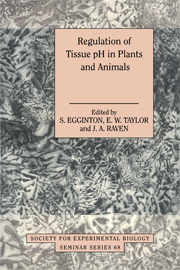Book contents
- Frontmatter
- Contents
- List of contributors
- Preface
- Measurement of intracellular pH: a comparison between ion-sensitive microelectrodes and fluorescent dyes
- pH-sensitive microelectrodes: how to use them in plant cells
- The use of nuclear magnetic resonance for examining pH in living systems
- Invasive studies of intracellular acid–base parameters: quantitative analyses during environmental and functional stress
- Lactate, H+ and ammonia transport and distribution in rainbow trout white muscle after exhaustive exercise
- Limiting factors for acid–base regulation in fish: branchial transfer capacity versus diffusive loss of acid–base relevant ions
- H+-mediated control of ion channels in guard cells of higher plants
- pH regulation of plants with CO2-concentrating mechanisms
- Intracellular pH regulation in plants under anoxia
- The role of turtle shell in acid–base buffering
- Acid–base regulation in crustaceans: the role of bicarbonate ions
- A novel role for the gut of seawater teleosts in acid–base balance
- pH and smooth muscle: regulation and functional effects
- Regulation of pH in vertebrate red blood cells
- Acid–base regulation in hibernation and aestivation
- Hepatic metabolism and pH in starvation and refeeding
- Back to basics: a plea for a fundamental reappraisal of the representation of acidity and basicity in biological solutions
- Index
Invasive studies of intracellular acid–base parameters: quantitative analyses during environmental and functional stress
Published online by Cambridge University Press: 22 August 2009
- Frontmatter
- Contents
- List of contributors
- Preface
- Measurement of intracellular pH: a comparison between ion-sensitive microelectrodes and fluorescent dyes
- pH-sensitive microelectrodes: how to use them in plant cells
- The use of nuclear magnetic resonance for examining pH in living systems
- Invasive studies of intracellular acid–base parameters: quantitative analyses during environmental and functional stress
- Lactate, H+ and ammonia transport and distribution in rainbow trout white muscle after exhaustive exercise
- Limiting factors for acid–base regulation in fish: branchial transfer capacity versus diffusive loss of acid–base relevant ions
- H+-mediated control of ion channels in guard cells of higher plants
- pH regulation of plants with CO2-concentrating mechanisms
- Intracellular pH regulation in plants under anoxia
- The role of turtle shell in acid–base buffering
- Acid–base regulation in crustaceans: the role of bicarbonate ions
- A novel role for the gut of seawater teleosts in acid–base balance
- pH and smooth muscle: regulation and functional effects
- Regulation of pH in vertebrate red blood cells
- Acid–base regulation in hibernation and aestivation
- Hepatic metabolism and pH in starvation and refeeding
- Back to basics: a plea for a fundamental reappraisal of the representation of acidity and basicity in biological solutions
- Index
Summary
Introduction
In recent years, studies of the effects of environmental variables on the physiology and biochemistry of different animal species have increasingly included an analysis of acid–base status and regulation. pH values in different body compartments are widely accepted to play a key role in the maintenance of physiological function or its limitation under functional or environmental stress. pH affects protein function in metabolism and O2 transport. Also, acid–base and metabolic regulation are interdependent processes such that changes in pH may affect metabolic rate, the mode of catabolism and energetic parameters. Ideally, these analyses should not only describe correlated changes in the different processes under investigation, but should also provide a quantitative picture of the changes involved and the processes responsible for them (Heisler, 1989b).
However, acid–base regulation not only means adjustment or defence of pH, which is traditionally seen as being the key acid–base parameter determining regulatory processes, but it may, under certain conditions and with the help of the respective membrane carriers (see below), also give priority to the regulation of the levels of base (carbonate, bicarbonate) or acid (carbonic acid, proportional to PCO2) in the respective body fluids. In that sense, pH would become a dependent variable. Also, for some treatments it is not pH which is of interest but rather the activity of protons (pH = –log aH+), when protons contribute to some biochemical reactions in a concentration-dependent manner (see equation 1, p. 73, as an example).
- Type
- Chapter
- Information
- Regulation of Tissue pH in Plants and AnimalsA Reappraisal of Current Techniques, pp. 69 - 98Publisher: Cambridge University PressPrint publication year: 1999
- 8
- Cited by

